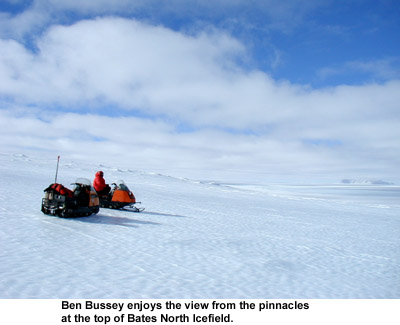 Program News
Program NewsDave Mittlefehldt
New Meteorites
This newsletter contains classifications of 197 meteorites from the 1999 ANSMET collection. The meteorites classified here were collected in six different areas, from the Allan Hills and Elephant Moraine in the north, to Lewis Cliff and Queen Alexandra Range in the south. Descriptions are given for twelve meteorites of special petrologic type. These include four carbonaceous chondrites, a type 3 ordinary chondrite, a type 6 ordinary chondrite containing a shock-melt vein, five HED achondrites, and an enstatite meteorite. The latter presents some classificational problems. It is clearly very much like three other meteorites recovered in previous years from the same icefield, yet these are variously classified as an E7 chondrite, or as aubrites. Neither of these classifications seems entirely appropriate. Rather than sort this problem out here, we have elected to punt, and provisionally call this new specimen an "enstatite meteorite, unusual." A brief scan of our database indicates that it is time to sort through problem samples and rationalize the entire database. In this regard, if you are aware of any classificational problems, let me know. My e-mail address is david.w.mittlefehldt1@jsc.nasa.gov.
JSC Lab Renovations
Work continues on upgrading our facilities. We have begun the process of replacing the air handlers in the Meteorite Processing Lab (MPL), having the ductwork cleaned, and adding HEPA filtration. Funding for the project has been secured, and ordering of equipment and parts has begun. We are expecting to start construction probably in April or May, and will be shut down for about six weeks. Once work is completed, the lab will be completely cleaned before starting new work. We will do our best to get all samples allocations done before the shutdown.
THE 2000-2001 ANSMET FIELD SEASON
Ralph Harvey
ANSMET's 24th field season (which ended January 15th) was a memorable one. In early December the field team (including R. Harvey, J. Schutt, B. Bussey, S. Russell, J. Byrnes, M. Strait, L. Nittler, and B. Oefelein) was put in at Meteorite Hills, a group of nunataks nestled between the headwaters of the Darwin and Hatherton Glaciers. This site had been scouted twice previously, in 1978 and again in 1996. Based on the earlier reconnaissance visits (which yielded a total of 60 specimens), we knew the region had the potential for significant returns; what was in question was just how significant they would be. John Schutt guessed we'd recover about 200 specimens; being the perpetual optimist, I guessed about 600. When the season was done (one of our best in terms of weather), Mother Nature proved that she was smarter than either of us - 740 specimens had been recovered.
 A better-than-usual proportion of these (about 73 specimens, roughly 10%) appeared to be of more interesting (that is, non-OC) classifications, so we look forward to their arrival at JSC with enhanced interest.
A better-than-usual proportion of these (about 73 specimens, roughly 10%) appeared to be of more interesting (that is, non-OC) classifications, so we look forward to their arrival at JSC with enhanced interest.
Reconnaissance efforts yielded an additional 18 specimens from a variety of icefields. Shortly after the full field team deployed, helicopter support from the nearby Darwn Glacier Camp allowed a series of short trips to local sites of interest. On the 11th of December a team of three visited Finger Ridge, recovering 3 meteorites during an hour's walk. Between Dec. 13 and 19, a team of two explored the icefields near Bates Nunatak, recovering an additional 11 specimens while systematically searching the entire area. Another trip (Dec. 19 to 26) by the same team (augmented by two Raytheon Polar Services employees, J. Pierce and K. Young) to Tentacle Ridge yielded two additional specimens on Christmas Day (thanks, Santa!) in some difficult searching conditions. Finally, two short daytrips to Derrick Peak each yielded an iron that is probably a new member of the well-known DRP iron shower.
Based on our success during the 2000-2001 season, we will be returning to several of these sites. Many areas of the extensive icefields at Meteorite Hills remain to be systematically searched, and the Finger Ridge site demands a higher level of reconnaissance. As we make plans for the upcoming 2001-2002 season we will certainly be considering a return to the region.